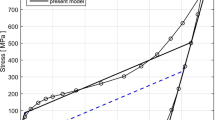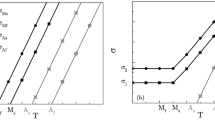Abstract
In this work, we briefly review the one-dimensional version of a well-known phenomenological shape memory alloy (SMA) constitutive model able to represent the main macroscopic SMA macroscopic behaviors (i.e., superelasticity and shape-memory effect). We then show how to identify the needed parameters from experimental results and, in particular, from strain-temperature tests. We finally use the obtained material parameters to test the prediction properties of the model, comparing numerical results with some experiments (different from those used for the identification), and we discuss model capabilities and further required enhancements.














Similar content being viewed by others
References
S. Govindjee, C. Miehe (2001) A multi-variant martensitic phase transformation model: formulation and numerical implementation, Computer Methods in Applied Mechanics and Engineering 191:215-238
D. Helm, P. Haupt (2003) Shape memory behaviour: modelling within continuum thermomechanics, International Journal of Solids and Structures 40:827-849
D.C. Lagoudas, P.B. Entchev, P. Popov, E. Patoor, L.C. Brinson, X. Gao (2006) Shape memory alloys, Part II: Modeling of polycrystals, Mechanics of Materials 38:391-429
P. Popov, D.C. Lagoudas (2007) A 3-D constitutive model for shape memory alloys incorporating pseudoelasticity and detwinning of self-accommodated martensite, International Journal of Plasticity 23:1679-1720
V.I. Levitas (1998) Thermomechanical theory of martensitic phase transformations in inelastic materials, International Journal of Solids and Structures 35:889-940
Peultier, B., Ben Zineb, T., Patoor,E.(2006). Macroscopic constitutive law for SMA: Application to structure analysis by FEM, Materials Science and Engineering: A 438-440 454-458
B. Raniecki, Ch. Lexcellent (1994) RLmodels of pseudoelasticity and their specification for some shape-memory solids, European Journal of Mechanics A: Solids 13:21-50
S. Reese, D. Christ (2008) Finite deformation pseudo-elasticity of shape memory alloys - Constitutive modeling and finite element implementation, International Journal of Plasticity 24 :455-482
A.C. Souza, E.N. Mamiya, N. Zouain (1998) Three-dimensional model for solids undergoing stress-induced phase transformations, European Journal of Mechanics, A: Solids 17:789-806
F Auricchio, L Petrini (2004) A three-dimensional model describing stress-temperature induced solid phase transformations: solution algorithm and boundary value problems, International Journal for Numerical Methods in Engineering 61:807-836
F. Auricchio, A. Reali, and U. Stefanelli (2009) A Macroscopic 1D Model for Shape Memory Alloys Including Asymmetric Behaviors and Transformation-Dependent Elastic Properties, Comput. Methods Appl. Mech. Eng.., 198:1631-1637
F. Auricchio, A. Reali (2007) A phenomenological one-dimensional model describing stress-induced solid phase transformation with permanent inelasticity, Mechanics of Advanced Materials and Structures 14:43-55
F. Auricchio, A. Reali, U. Stefanelli (2007) A three-dimensional model describing stress-induced solid phase transformation with permanent inelasticity, International Journal of Plasticity 23:207-226
F. Auricchio, L. Petrini (2004) A three-dimensional model describing stress-temperature induced solid phase transformations: thermomechanical coupling and hybrid composite applications, International Journal for Numerical Methods in Engineering 61:716-737
Author information
Authors and Affiliations
Corresponding author
Additional information
This article is an invited paper selected from presentations at Shape Memory and Superelastic Technologies 2008, held September 21-25, 2008, in Stresa, Italy, and has been expanded from the original presentation.
Rights and permissions
About this article
Cite this article
Auricchio, F., Coda, A., Reali, A. et al. SMA Numerical Modeling Versus Experimental Results: Parameter Identification and Model Prediction Capabilities. J. of Materi Eng and Perform 18, 649–654 (2009). https://doi.org/10.1007/s11665-009-9409-7
Received:
Revised:
Accepted:
Published:
Issue Date:
DOI: https://doi.org/10.1007/s11665-009-9409-7




